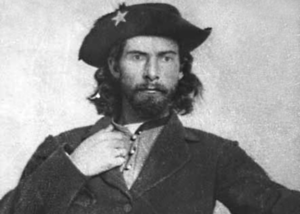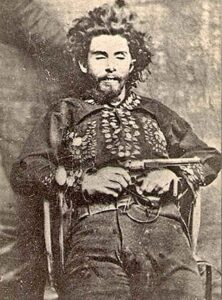 William T Anderson’s life was always rather a violent one, but it escalated when his sister died while in the custody of the Union soldiers during the Civil War. Anderson was born around 1840 in Hopkins County, Kentucky, to William and Martha Anderson. His siblings were Jim, Ellis, Mary, Josephine, and Martha. His schoolmates recalled him as a well-behaved, reserved child, so they might be surprised to see how he ended up. Anderson began to support himself early on, by stealing and selling horses in 1862. After a Union loyalist judge killed his father, Anderson killed the judge and fled to Missouri. He was always one to exact revenge for anything in which he felt that he or his family were wronged. In Missouri, he robbed travelers and killed several Union soldiers.
William T Anderson’s life was always rather a violent one, but it escalated when his sister died while in the custody of the Union soldiers during the Civil War. Anderson was born around 1840 in Hopkins County, Kentucky, to William and Martha Anderson. His siblings were Jim, Ellis, Mary, Josephine, and Martha. His schoolmates recalled him as a well-behaved, reserved child, so they might be surprised to see how he ended up. Anderson began to support himself early on, by stealing and selling horses in 1862. After a Union loyalist judge killed his father, Anderson killed the judge and fled to Missouri. He was always one to exact revenge for anything in which he felt that he or his family were wronged. In Missouri, he robbed travelers and killed several Union soldiers.
Anderson became a guerrilla, when his family was living in Council Grove, Territory of Kansas at the start of the Civil War. After William Quantrill’s raid on Aubry, Kansas on March 7, 1862, a Federal company from Olathe, Kansas sent a patrol from Company D, Eighth Kansas Jayhawker Regiment to investigate. Their mission was to seek out Southern sympathizers living nearby, who might be accused of aiding the raiders. Anderson’s father and uncle were named as such, and when the Jayhawker company arrived at the Anderson farm on March 11th, William and his younger brother Jim were delivering 15 head of cattle to the US commissary agent at Fort Leavenworth. When the brothers returned to their farm, they found their father and uncle hanged in retaliation, their home burned to the ground, and all their possessions stolen. It was an act of war in their minds, because the men had no chance to defend themselves. Two days later Bill and his brother Jim were both riding with Quantrill’s Raiders, a group of Confederate guerrillas operating along the Kansas–Missouri border. Anderson moved his sisters from Kansas, and for a year they lived at various places stopping finally with the Mundy family on the Missouri side of the line near Little Santa Fe. When asked why he joined Quantrill, Anderson replied by saying, “I have chosen guerrilla warfare to revenge myself for wrongs that I could not honorable revenge otherwise. I lived in Kansas when this war commenced. Because I would not fight the people of Missouri, my native State, the Yankees sought my life but failed to get me. [They] revenged themselves by murdering my father, [and] destroying all my property.”
Anderson became a skilled bushwhacker and quickly earned the trust of the group’s leaders, William Quantrill and George M Todd. It was his bushwhacking skills that ultimately marked him as a dangerous man…and eventually led the Union to imprison his sisters. Then, after a building collapse in the makeshift jail in Kansas City, Missouri, left one of his sisters dead, while in custody and the others permanently maimed, Anderson devoted himself to revenge. He took a leading role in the Lawrence Massacre and later took part in the Battle of Baxter Springs, both in 1863. He later satisfied his revenge by hijacking a train full of Union troops and slaughtering 24 of them, thus giving him the name “Bloody Bill” Anderson.
By 1863, all Bill had left was a brother and two sisters, who had miraculously survived the August 13 Union jail collapse in Kansas City. The collapse wasn’t an accident. Union guards from the 9th Kansas Jayhawker Regiment, serving as provost guards in town, intentionally collapsed a three-story brick building on a number of young Southern female prisoners. Fourteen-year-old Josephine Anderson was killed in the collapse. Bill’s ten-year-old sister Martha’s legs were horribly crushed crippling her for life, and his sixteen-year-old sister Mary suffered serious back injuries and facial lacerations. Both girls would carry their physical and emotional scars for the rest of their lives. War is an ugly thing, and unfortunately, sometimes unscrupulous people do things  they shouldn’t. The atrocity at the jail was a war crime and should have been punished as such, but I suppose that didn’t justify the murders that followed, because there was no proof that those murdered were involved in any way.
they shouldn’t. The atrocity at the jail was a war crime and should have been punished as such, but I suppose that didn’t justify the murders that followed, because there was no proof that those murdered were involved in any way.
Union military leaders ordered Lieutenant Colonel Samuel P Cox to kill Anderson and provided him with a group of experienced soldiers. A local woman saw Anderson soon after he left Glasgow and told Cox where he was. On October 26, 1864, Cox pursued Anderson’s group with 150 men and engaged them in a battle called the Skirmish at Albany, Missouri. Anderson and his men charged the Union forces, killing five or six of them, but turned back under heavy fire. Only Anderson and one other man, the son of a Confederate general, continued to charge after the others had retreated. Anderson was hit by a bullet behind an ear, which most likely killed him instantly. Four other guerrillas were killed in the attack as well. The victory made a hero of Cox and led to his promotion.


Leave a Reply